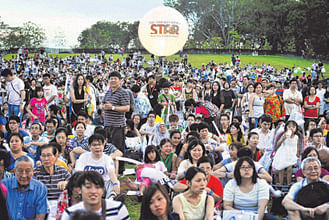LIVING HISTORY
Where the grass is greener
LIFE & TIMES: OUR CITY
Sign up now: Get ST's newsletters delivered to your inbox
Follow topic:
A TRAVEL ACCOUNT published in The Straits Times on June 15, 1872, marvelled at "the Eden-like beauty" of the "fine public garden" where "roads, lawns, lakes with swan sporting upon their surface" and "every variety of tropical plants and flowers" abounds.
The writer was, of course, describing the 156-year-old Botanic Gardens which clinched the prestigious Unesco World Heritage Site status, in a first for Singapore earlier this month.
Over the last 170 years, The Straits Times has chronicled, in picture and prose, the changing face of Singapore.
Here is how the Singapore River was described in 1937: "Sewer for a section of a big city, muddy, slushy artery of internal commerce, torpid home of a thousand sampan families and background for tens of thousands of snapshots, the river is the most evil-odoured of Singapore sights". A far cry from the glitzy waterfront it is today.
Still, to find some good in a bad situation, a 1933 column said the rotten waste in the river functioned as a barometer to predict the weather. The decaying vegetation in the river gives off gas and, at times, bubbles would appear at a specific atmospheric pressure - a sign of an impending storm. Occasionally, the river would look like it was on fire when the gas combusted.
With Orchard Road, the grouse was - no surprise - traffic. Letters to The Straits Times would complain about the dangerous manner in which the road was being used - particularly by horse-riders. In one letter published in 1902, the writer wondered if Orchard Road had been converted to a training ground for the animals.
If you were a resident of Katong in the late 1800s, it is likely you were a victim of at least a petty crime or two. Reports in The Straits Times revealed the high incidence of crime in Tanjong Katong as early as 1848. In some cases, thieves cut holes in the side of houses, while pirates hijacked sampans and attacked boatmen. The reports could be comical in details. In 1898, a man was charged with stealing coconuts from a tree on private property at Tanjong Katong.
"The prosecutor caused some laughter," the report said, "by stating that the prisoner waited up the tree for three hours watching his opportunity to descend, and a servant had ultimately to be sent up to bring him down." It was two months in jail and 10 strokes of the rattan for the culprit.
Katong Park was a popular leisure spot - despite occasional sightings of crocodiles in the early 1930s - until it lost its sea frontage to reclamation in 1966. Children and families were often photographed frolicking in the waters of the Katong Swimming Pagar, which opened in 1931 and was enclosed by a pagar (a fence in Malay) to protect swimmers from shark attacks.
In the 1960s, sharks were also said to infest waters surrounding the marshes of Jurong, which is today an industrial, business and shopping hub.
When Nanyang University was opened here in 1958, more than 20,000 people showed up at its opening ceremony, which caused the "biggest traffic jam in Singapore's history". Many had to abandon their cars at the roadside and walk the rest of the way to the new university, the first outside China catering to high school graduates from Chinese schools. Nanyang University merged with the University of Singapore in 1980, forming the National University of Singapore. • ST
- View a picture-spread capturing the changing face of Singapore's key landmarks - in our ebook LIVING HISTORY: 170 years of The Straits Times.
- Available through The Straits Times STAR app which can be downloaded free on Apple and Android tablets.

2012
ST COMMUNITIES
Mr Han Fook Kwang hands over editorship to Mr Warren Fernandez and The Straits Times is revamped to give it a fresh contemporary look.
ST Communities is launched to allow readers, journalists, artists and community partners to get published alongside one another.

The paper kicks off the Straits Times Appreciates Readers (STAR) programme on its 167th birthday with a carnival and concert at Gardens by the Bay. The programme is launched to reach out and connect with readers of The Straits Times.

2013
ST RUN

The annual ST Run is launched. The inaugural event at Punggol Waterway is attended by 12,000 participants. The Straits Times steps up efforts to engage readers through a series of public forums on education, investments and foreign affairs.
SPH embarks on a 10-month transformation project to keep the company in sync with the changing media landscape. Editor-in-chief Patrick Daniel notes that digital growth has ''more than offset'' the decline in print circulation.

2015
170 YEARS OLD
The Straits Times celebrates its 170th anniversary with a major revamp of all products, offering a new look and sharper content on its print and website editions and over its apps for smartphones and tablets. The newspaper also holds its rst-ever public exhibition, drawing on its news archives of photographs and Page 1 coverage, to showcase its history.
Sources: THE STRAITS TIMES ARCHIVES AND DATELINE SINGAPORE, A BOOK BY CM TURNBULL ST GRAPHICS

